How to Conduct
a Job Interview
THE COMPLETE GUIDE
Everyone has been interviewed before. But have you ever sat on the other side of the table, as the interviewer? Whether it’s your first time conducting a job interview or you need a refresher, this guide will walk you through everything you need to know to conduct interviews that are professional, effective, and designed to help you make a confident final hiring decision.

Table of Contents
Section 1: Why Conduct Job Interviews?
Section 2: Good vs. Bad Job Interviews
Section 3: How Bias Impacts Job Interviews
Section 4: How to Write Good Interview Questions
Section 5: Interview Questions to Avoid
Section 6: Preparing to Conduct a Job Interview
Section 7: Best Practices for Conducting Job Interviews
Section 8: After the Interview
Section 9: Legal Considerations
Section 10: Tools for Conducting a Job Interview
Section 11: Key Takeaways for How to Conduct a Job Interview
SECTION 1
Why Conduct Job Interviews?
Conducting a job interview isn’t just a box to check in the hiring process. It’s a critical opportunity to learn more about your job candidates so you can make an informed decision about who to hire.
In fact, interviews are considered one of the most important parts of the selection process, with 94% of hiring professionals ranking them as "very valuable" for making informed hiring decisions.
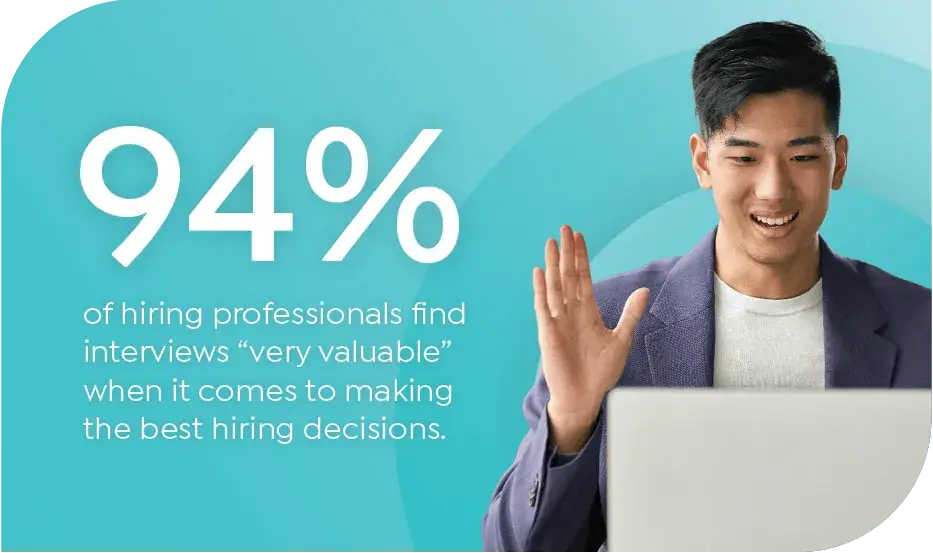
An effective job interview will increase your chances of making a good hire – picking the candidate who will thrive and succeed in the role. In contrast, an ineffective job interview may result in a bad hire – picking a candidate who underperforms, doesn’t get along with the team, negatively impacts morale, or makes critical errors at work that can be costly to correct. Yes, the stakes really are that high!
Before you step into an interview, it’s important to remember what you are trying to accomplish. By the time the interview stage rolls around, you likely have already seen the candidate’s resume and have a basic understanding of their experience. It’s also possible that the candidate has already undergone an initial phone screen, and that the candidate may have already taken a few assessments to demonstrate their fit for the role. The interview is your chance to:
- Confirm the candidate’s skills and knowledge
- Expand on that information with targeted questions
- Learn more about the candidate’s goals, values, and interests as it pertains to the role
- Share more information about the role
- Give the candidate the opportunity to ask questions about the role.
Why does this all matter? Well, interviews are one of the most time-consuming parts of the hiring process, so it’s vital to make every interview worth the time investment, both for you and the candidate.
In this guide, we will provide you with the tools you need to conduct job interviews that are more efficient, effective, and objective, increasing your chance of making a good hire.
Interviews sit at a critical intersection in the hiring process, where human nature and curiosity intervene with objectivity and information gathering.
SECTION 2
Good vs. Bad Interviews
What separates a good interview process from a bad one? Since the goal of any hiring process is to determine the best person for the job, a good interview will help ensure that happens by keeping interview questions on-topic and job relevant.
In contrast, bad interviews often focus on qualities that have nothing to do with success on the job. These include things like a candidate’s:
- Likeability or charisma
- Physical appearance
- Personal connections
- Alma Mater
- Perceived similarities with the interviewer
While these traits may make sense to evaluate when building relationships outside of work, they are inappropriate to consider during the hiring process and cloud an interviewer’s judgement. In the 90s, it was common to think that you should “hire the guy you want to get a beer with after work.” But this decision-making process entirely ignores how well a person will function in your organization.
Hallmarks of Good and Bad Interviews
A GOOD Interview | A BAD Interview |
| Focuses on job-related skills and competencies | Focuses on personality, appearance, or other superficial (and misleading) signals |
| Plans out the interview structure ahead of time | Doesn’t use pre-planning |
| Asks every candidate the same questions | Asks candidates different sets of questions |
| Uses a rating scale for each question | Doesn’t rate candidate responses across a standard rating scale |
| Asks questions that are specific and relevant to the role | Asks questions that don’t relate to the job or organization |
| Avoids topics that are illegal or inappropriate to ask candidates | Includes questions about age, gender, race, relationship status, or disability |
| Creates a welcoming and comfortable environment for candidates | Creates an intimidating, confusing, or high-stress atmosphere |
| Allows candidates to ask questions and learn more about the role and organization | Doesn’t give candidates the time to ask questions |
| Seeks to minimize bias and enhance objectivity | Doesn’t pay particular attention to bias |
| Is well-organized and efficient | Is meandering, spontaneous, and inefficient |
Despite being a high-stakes game, there’s a lot within your control to avoid bad interviews (and therefore bad hires). In this job interview how-to guide, we’ll explain how anyone tasked with hiring can set themselves up for success and make the best possible decision.
We’ll cover what you can do to make sure you conduct good interviews, including:
- Writing good interview questions
- Minimizing bias as much as possible
- Following a structured interview process
Structured interviewing at a glance
Structured interviews use two main principles to help make the process both more effective and more fair.
- Each interview will use a common set of standardized interview questions that are designed to measure job-related qualities.
- Every candidate is evaluated using a standardized scoring system.
Research shows that not only are structured interviews the single best predictor of future job success, but that 7 out of 10 candidates want to be asked the same questions as their peers during the hiring process.
Not sure how to get started with structured interviewing? Check out the Complete Guide to Structured Interviews next.
SECTION 3
How Bias Impacts Job Interviews
When it comes to mitigating bias during hiring, the worst strategy is to ignore it and assume objectivity will come naturally. Decades of research have demonstrated that humans are predisposed to bias. This natural tendency – once crucial for survival – makes it hard to be objective when making decisions about other people, including during the hiring process.
And experiencing bias isn't rare. According to recent data, 27% of candidates have experienced bias during an interview.

One of the best protections against bias is to simply be aware of our innate biases, especially those that are most common in interviews.
Types of Interview Bias
Some forms of bias will be more prevalent during job interviews than others, as interviews are one of the most person-focused steps of the hiring process. Regardless of whether an interview is over the phone, virtual, or in-person, it’s vital to be aware of our internal biases so we can work to mitigate their effects.
Let’s look at a few prevalent types of biases that often creep up on interviewers:
Confirmation bias encourages us to only take in new information that matches our already-existing beliefs (and to ignore information that doesn’t fit). During an interview, that might mean that we’re more inclined to favor a person whose resume we really liked, giving too much weight to their responses that meet our expectations, and ignoring or excusing questions that they fumble through.
Interviews are designed to give us an impression of how well a given person might do in a role, and it’s often where you as the interviewer gain your first impression of a candidate. That’s when the Halo Effect (and, conversely, the Horns Effect) can kick in. This is a form of confirmation bias that allows the first impression (good or bad) to color subsequent interactions in accordance with that initial vibe check. For example, if a candidate has experience at a company you think highly of, you’re more likely to latch on to that one positive aspect and wave away other potential red flags as a result.
And if you’re part of a panel of interviewers, you need to be aware of the Bandwagon Effect – where our feelings are skewed by the opinions of those around us. This is why it’s especially important to record and submit your candidate evaluations prior to having any discussion about a candidate with other interviewers.
10 Most Common Interview Biases
- Confirmation Bias
- Recency Bias
- Halo/Horns Effect
- Commitment Bias
- Social Comparison Bias
- Affect Heuristic
- Group Attribution Error
- In-Group vs. Out-Group Bias
- Contrast Bias
- Stereotyping
To learn more about these and other types of bias that can infiltrate the hiring process, see the full list of 21 Harmful People Biases that Impact Hiring.
When you know how to identify biases, you’re better able to mitigate their effects and reduce their impact on your hiring decisions.
SECTION 4
How to Write Good Interview Questions
The success of your interview hinges on the questions you choose to ask your candidates. For many interviewers, deciding what to ask is one of the biggest challenges. It can feel like there’s an infinite list of questions that need to be asked, and not enough opportunity to ask them.
Fortunately, creating a set of good interview questions is easier than you might think:
STEP 1:
Consider what you want to learn from the job interview
The job description is already written and contains a ready-made list of the skills you’re seeking for this role. Which of those skills do you want to assess or confirm during the interview? This will inform which topics you’ll need to create questions around. You may want to focus on traits and abilities that don’t come across well in a resume, or to investigate the depth of skills that are critical to success in the role.
Additionally, consider where the interview sits in the hiring process. Will it come after assessments, or a phone screen? This will inform skills you might want to assess in the interview, as their assessment results could provide objective confirmation of certain abilities before ever scheduling an interview.
STEP 2:
Choose the best interview format
The interview format you decide to use may influence the kinds of questions you choose to include. The most common interview formats are video, one-on-one, or panel interviews. Each one has their own benefits and drawbacks, but the reality is that candidates don’t really care which interview format is used – they care whether or not they are given a fair shot to represent themselves.
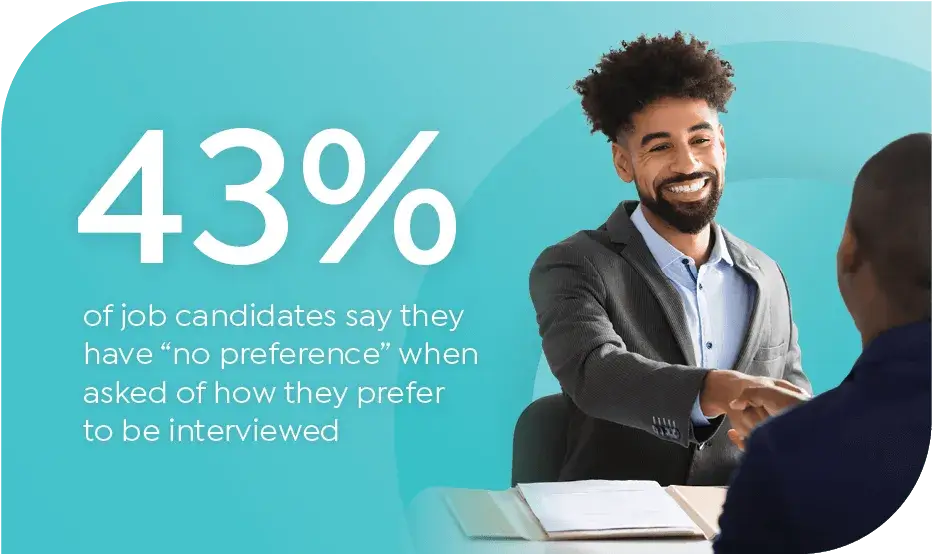
You should also consider the number of interview rounds a candidate has already gone through with your organization. Candidates don’t typically appreciate having to answer the same questions from previous rounds. To steer clear of forcing a candidate to rehash their responses, request a list of the questions used in prior rounds of interviews (if applicable).
If you aren’t sure what questions have already been asked, focus your inquiry on how their specific skills are suited to the role you’re hiring for (as opposed to more general questions about work ethic, their background, or where they see themselves in 5 years).
Keep candidate experience top of mind while designing your interview. In our 2024 Candidate Experience Report, we uncovered the biggest things to avoid as an interviewer:

As the interviewer, you have control over most of these common pitfalls. While you may not be able to control the number of interviews a candidate has to go through, you can make sure that you show up on time, stick to job-related questions, and prepare for the interview ahead of time.
STEP 3:
Write interview questions
If you work at a larger organization, it’s very likely that your HR or talent acquisition team will provide you with (or help to develop) a set of interview questions for the candidate. In this case, be sure to stick to the approved list of questions you’ve been provided and do not deviate during the interview.
But if you work at a smaller company, as a hiring manager you may have the opportunity to write questions on your own. And remember: these are the questions you need to ask every candidate, so don’t base questions on specific experience one candidate included in their resume.
Featured Resource: How to Design Structured Interviewing Questions
The questions you write should be hyper-focused on assessing each candidate’s job-relevant skills and how well they will align with your organization’s goals and needs.
Types of Interview Questions
Depending on what you’re trying to accomplish, there are different types of interview questions you should consider:
Behavioral interview questions
Behavioral interview questions target the way a candidate navigated situations in the past. These questions look to investigate how a person has approached issues previously and how their work history might carry over into the position you’re hiring for.
Tell me about a time when you had to step up and demonstrate leadership skills. What did you learn from that experience?
Let’s talk about a time when you set a goal for yourself. What did you do to make sure you would achieve that goal?
Situational interview questions
While behavioral questions investigate past behavior, situational interview questions focus on how a candidate would handle a hypothetical situation. This type of question is future-facing and allows you to see how a candidate would approach common challenges in their potential new role.
What would you do if you ran into a problem you weren’t able to solve?
How would you manage a situation where you disagree with a coworker on how to proceed with a project together?
Case interviews
Case interviews are designed to evaluate a candidate’s ability to analyze and solve problems effectively by providing them with a business scenario that they need to propose a solution to. These types of interview questions are more suited for strategic roles, like consultants or higher C-suite roles, as they often require knowledge of business strategy.
A client wants to enter a new market to grow their watch business. After decades of success in the US, they want to bring their product to Europe. Help the client determine how to successfully approach this new European market and further their growth.
Propose a new product to add to our offerings. What is this new product and why is it a viable innovation for our business?
Technical assessments
A technical assessment is designed to evaluate a candidate’s specific hard skills and capabilities needed to succeed in the role. It assesses the depth of a candidate’s knowledge and their ability to think under pressure.
These types of questions tend to be most useful in roles that hinge on hard skills, like confirming a candidate has the coding skills they’ve listed on their resume, or their ability to meet the requirements of a role. They focus on asking questions to confirm a candidate’s depth of knowledge, weeding out people who may have overstated their qualifications.
Examples of Good Interview Questions
A good interview will use a blend of different question types to get a well-rounded view of a candidate. You probably won’t need to use each type in every interview, but understanding the goals of each kind of question can help you know which ones will unlock the information you’re looking for.
Remember: All questions should be job-relevant and focused on assessing a candidate’s capacity to thrive at your organization.
Let’s say you’re interviewing candidates for a customer service representative position on your team – you’re going to want to focus your questions on confirming that a candidate possesses the specific skills you know they’ll need to succeed.
- Give an example of a time when you were able to stay calm during a chaotic situation and how you were able to focus on the task at hand.
- Discuss a time you defused a tense situation with an angry customer when they were being unreasonably demanding.
- How would you approach a situation where the customer is clearly wrong, but you need to keep them satisfied to retain their business?
- What would you do if you didn’t know the answer to a customer’s question?
- How would you handle getting negative feedback from a customer? What about from a coworker?
Questions like these will provide valuable insight into how each candidate’s experience, current abilities, and personal approach to solving problems would play out if you chose them for the job. Good questions should be focused on common challenges and skills that a new hire will need to succeed on your team.
Quick Tip
Feeling stumped? Try asking ChatGPT for interview question ideas or to jumpstart your question list.
10 Interview Questions to Try in Your Next Interview
While some of these might need a few tweaks to tailor them to the specific role you’re interviewing for, this list is a great starting point for your interview question brainstorm:
- If you run into a problem at work, what approach do you take to resolve it? What do you do if you can’t solve it?
- How do you stay organized?
- What does your ideal work environment look like?
- Share a recent accomplishment you’re most proud of.
- What are the three most valuable skills you bring to the table and why?
- Tell me about a time you made a mistake and what you did to fix the issue.
- While you’re in the middle of completing one task, your supervisor asks you to stop working on your current project and prioritize something entirely different instead. You’re nearly done with your current task. What do you do?
- How do you handle stress at work?
- Tell me about a time when you provided a creative solution to someone’s problem.
- Talk about a time when you turned an obstacle into a learning opportunity. What did you learn? How has this impromptu education helped you in the long run?
SECTION 5
Interview Questions to Avoid
We’ve covered the good… Now what about the bad and the ugly? Inappropriate interview questions are a huge turnoff for candidates, with 64% of candidates saying that the biggest mistake an employer can make is asking inappropriate or personal questions during an interview.
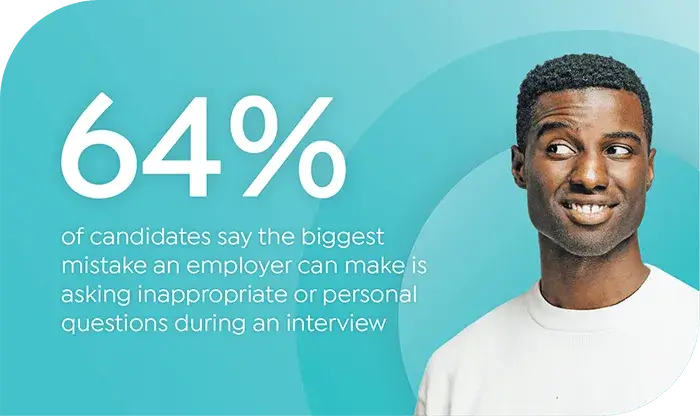
Bad interview questions ask for information that is:
- Irrelevant to the job
- Personal, especially regarding political, religious, or relationship matters
- Potentially discriminatory against a protected class (age, sex, race, gender, sexuality, religion, etc.)
- Uncomfortable for the candidate to answer
A question you’re thinking of throwing in because it “seems fun” could completely derail your interview and leave a bad taste in a candidate’s mouth.
Here are 13 examples* of bad interview questions:
- If there was to be a movie about your life, which Muppet character would play you and why?
- Are you married?
- How old are you?
- How does your husband feel about you exploring this position?
- If you were a dog, which breed would you be?
- Do you plan to start a family soon?
- What basketball team do you support?
- Tell me a joke.
- What is your favorite curse word? Use it in a sentence about your last job.
- What do you think of garden gnomes?
- Have you experienced any serious illnesses in the past year?
- At your age are you sure that you can relate to our younger employees and customers?
- What leadership skills are needed to cook a chicken?
From the absurd to the illegal, interview questions like this won’t help you break the ice or get any closer at identifying the best person for the role. Stick to questions that will help you learn more about the person’s capacity for doing the job and how they will mesh with other members of your team.
*These questions were submitted by audience members during a Criteria-led webinar
SECTION 6
Preparing to Conduct a Job Interview
Once you’ve determined the questions you’ll be asking your candidates as a part of the interview, it’s time to put in the effort to make sure the interview process goes smoothly before, during, and after.
Lay the Groundwork
Simply put: BE PREPARED. There’s no winging it, you can’t come up with an effective and impartial interview on the fly. 55% of candidates believe that being unprepared for an interview are one of the biggest mistakes a hiring manager can make.
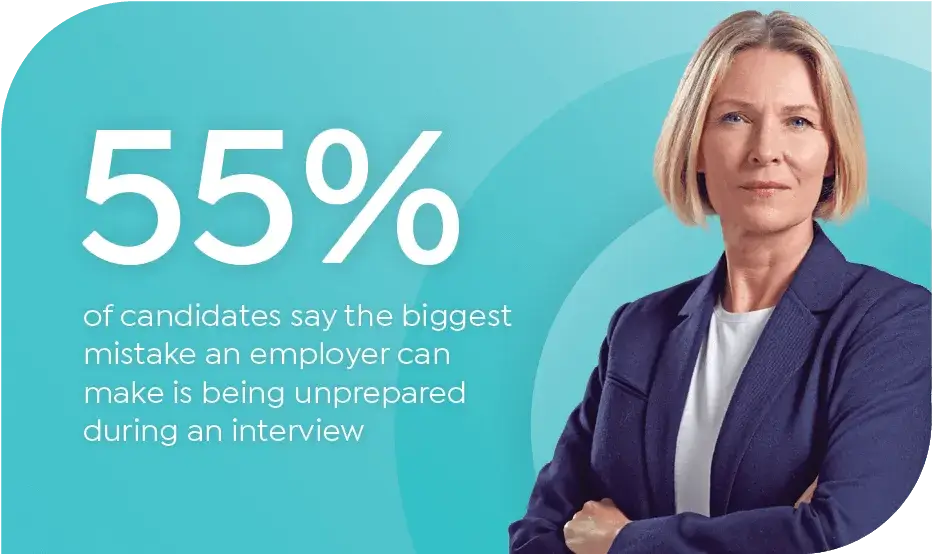
Going into an interview without preparation is at best a waste of your and the candidates’ time, and at worst can lead to a bad hire.
Depending on the size of your organization, your HR or talent acquisition team might do the bulk of the prep work for you. They may provide structured interview guides, create rubrics for evaluating candidates, design questions, and put together candidate evaluation forms after the interview is completed.
If you’re part of a smaller team, these responsibilities may very well fall to you as the hiring manager. As we just covered, you’ll create the questions you want to ask, but you’ll also need a way to quickly, objectively, and effectively evaluate candidate responses in real time.
For smaller teams, it comes down to creating simple five-point rubrics to help you evaluate each answer on a level playing field across each candidate. This is standard practice when creating a structured interview.
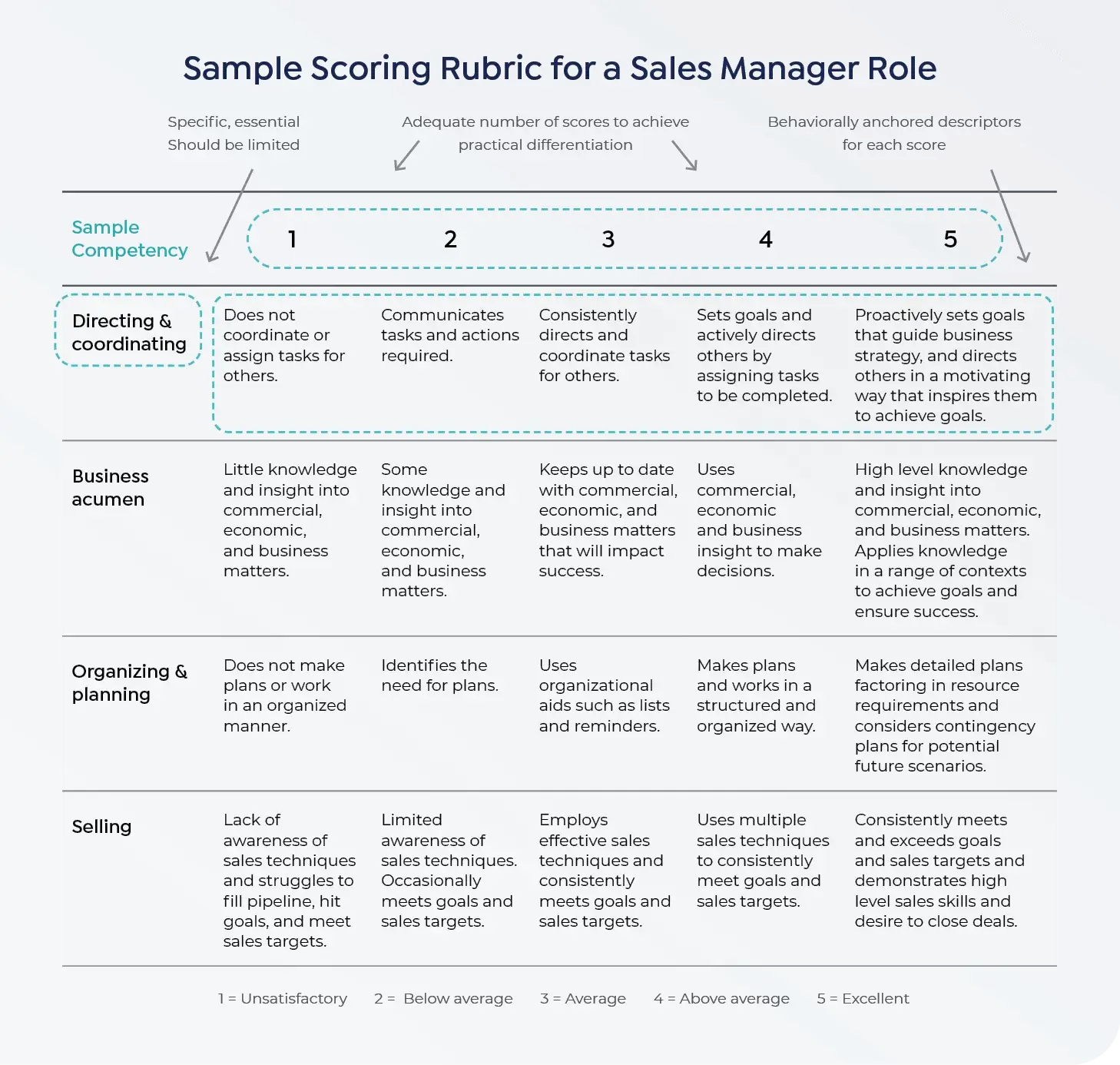
Creating these rubrics takes a bit more time upfront, but it’s a worthwhile investment, as it streamlines your candidate evaluation process significantly, allowing you to compare candidates quickly and accurately.
Familiarize Yourself with Interviewing Techniques
Decide on whether behavioral interview techniques, situational interview questions, case interviews or technical assessments are the best for evaluating candidates for the role you’re interviewing for.
The split of hard vs. soft skills that the job demands, the type of job (entry, mid, or senior level), and your team’s current dynamics will all influence the type of interview techniques you’ll select to help you find the best person for the role.
Use behavioral indicators and job-specific competencies to prioritize skills-based hiring, which can help create more predictive interview. You can also focus on evaluating universally valuable abilities, like problem-solving and critical thinking, or assessing cultural fit and soft skills.
Understand and Mitigate Biases
Check your bias at the door. When you’re interviewing someone, it’s imperative that you understand your own internal bias and preconceived ideas so that they don’t cloud your judgment.
Review our bias guide and familiarize yourself with how to overcome some of these common hiring biases, while also shoring up the rest of your interview practice with strategies that prioritize objectivity, like structured interviewing.
Featured Resource: Structured Interviews: A Quick Guide for Hiring Managers
Communicate with Candidates
Interviews are a two-way street. Crafting a positive candidate experience will set your interview process up for success. It often comes down to the Golden Rule: treat candidates how you’d like to be treated.
That means providing clear and open communication ahead of the interview, offering flexibility where you can during scheduling, and laying the foundation for a healthy professional relationship. After all, from a candidate’s perspective, the way you treat them during the hiring process is likely indicative of how they will be treated after they’ve joined the team.
Featured Resource: Candidate Communications Toolkit
Get started on the right foot by communicating with candidates in a way that helps set the tone for the interview. You should also take the time to set up the interview space to promote productive conversation. Whether physical or virtual, your goal is to create a comfortable environment that is free of distractions, easy to hear one another, and fosters connection (even if it’s over wi-fi!).
SECTION 7
Best Practices for Conducting Job Interviews
Now that you’ve done all the prep work for a successful interview, it’s game time. Here are the things you should be keeping in mind during the interview. As an interviewer, it’s your job to identify the strongest contender for the role. Here are our top tips for ensuring that happens:
1. Ask each candidate the same questions, in the same order
A key tenant of structured interviewing, make sure you stick to the plan when interviewing! Don’t deviate or throw in new questions on a whim. To fairly assess your candidates, you need to give each person equal opportunity to present themselves. Last minute changeups jeopardize that.
2. Give each response a rating using your rubric
Don’t wait until after the interview to grade a candidate’s replies. You want to evaluate them while their answers are fresh in your mind. Take brief notes and score each response with the rubric before moving on to the next question.
3. Seek to minimize bias
Bias is the enemy of good hiring decisions. By being aware of non-verbal cues and personal biases, you’ll do your part in reducing the impact that bias has on finding the best person for the job.
Lean on structured interviewing to ensure consistency in questioning and evaluation. Trust the process and see it through.
Avoid asking personal questions, questions not related to the job at hand, and steer clear of illegal interview questions.
4. Sell the company and the position
The candidate isn’t the only one that’s trying to make a good impression. As the interviewer, you’re the de facto spokesperson for your organization. It’s your job to help the candidate understand what a day in the life is like, what it will be like to join your team, and make them eager to accept an offer.
Just as the candidate is selling themselves, you’re selling what it’s like to work together – share what you love about being a part of your organization, your job, and its importance to you. The interview is the best way to help a candidate envision themselves in the role and get excited about the opportunity.
5. Create a comfortable environment for candidate
Open the interview by setting a comfortable and conversational tone. At the start of the interview, remember to introduce yourself and the company. While small talk can help ease candidate nerves, it’s best to keep this kind of light conversation out of the interview process itself.
For example, it’s completely fine to offer a candidate water while walking to the interview space, but not to ask them if they have any pets once you’ve sat down and started the actual interview. Save these sorts of questions for after the evaluation portion of the interview has concluded to avoid creating unintentional bias.
To create a positive candidate experience, help make each candidate feel welcome and that their time is appreciated.
6. Assess candidate responses objectively
When you spend the time to make a robust rubric upfront, you’ll be able to quickly check off which candidates are acing their responses and those who might be missing the mark. In general, focus on quieting your gut instinct and trusting objective and predictive measures of success.
Often, you’re going to be interviewing multiple candidates (and sometimes you might have a full day of back-to-back interviews) before making your final decision. Taking notes on each candidate during the interview is a great way to keep them straight and avoid recency bias or your interviews blurring together.
7. Close the interview
After giving candidates the opportunity to ask their own questions, it’s good to close the interview on a positive note.
Start by summarizing the interview process for the candidate, explaining the next steps and the timeline of when they can expect to hear from your next.
Always close by thanking the candidate for their time – even if the interview didn’t go well and you don’t plan on hiring them. There are no downsides to treating each candidate with respect and thoughtfulness.

SECTION 8
After the Interview
Interviewing well takes a lot of time and effort, and even after every candidate has been interviewed, your role isn’t done yet. If anything, the rubber doesn’t meet the road until after all interviews have been conducted.
Submitting Interview Notes
After each interview, complete ratings and finalize your notes as soon as possible to preserve accurate memory. Otherwise, you could conflate two candidates or forget important details they shared during their interview.
Don’t confer with other interviewers until you complete and submit your ratings and your notes. Pre-emptive discussions can inadvertently skew your scoring and lead to bias.
Debriefing with the Interview Team
If you’re part of a panel of interviewers, schedule time to meet and discuss your thoughts on the candidates you’ve spoken to. Importantly, make sure to hold off on sharing impressions and observations until AFTER all scores have been compiled.
During these debriefs, discuss candidate strengths and weaknesses, their potential overall fit with the team, and their short term and long-term trajectory at your organization.
If you’re the sole interviewer to fill a position, be sure to hold off on “making your choice” before all candidates have had a chance to interview. Deciding you like the second candidate the most before interviewing 4 other people can cause you to compare each subsequent candidate not to the responsibilities of the role you’re hiring for, but to the other candidate you preferred.
Making the Decision
After all candidates have interviewed and all evaluations have been submitted, it’s time to make your choice about who to offer the job to. Compare candidates against job requirements – who will be able to perform the essential duties of the role the best? Do they seem interested in the role long-term?
And if you’re using a robust structured interviewing process with a rubric, you’ll be able to quickly tally up the points that each candidate scored for more objective comparison. This will give you a numerical score for each candidate that you can then use to inform your final decision, alongside the other factors like their past experience and assessment scores.
In addition to their competency, consider team fit and their potential for growth. Is there a candidate with a high capacity for leadership? Will they bridge a skills gap for your team? Or do they check most of the job requirements, but will clash with how your other team members operate?
There’s a lot to consider when making the decision on who you want to hire. It’s easy to default and try to go with your gut, but we encourage you to lean on objective measures of performance instead. Review any additional data points when making your decision, like the results of any assessments or personality tests.
If you have followed the best practices we outlined previously, you’ve got a high chance of making a great hire.
Following Up with Candidates
One thing to keep in mind is the speed of your decision-making process. Candidates have high expectations when it comes to communicating with prospective employers. For example, did you know that 34% of candidates assume they’ve been ghosted if they haven’t heard back after just one week? And if a candidate assumes an employer has ghosted them, they’ll move on and look for different opportunities – potentially with your competitors!
Send a follow-up email to your interviewees that lets them know the date you’re expecting to make your decision by so they don’t feel like they’ve been left hanging.
And once you’ve made your decision, it’s time to let your candidates know. Send out an offer to your top candidate and confirm their acceptance before you start breaking the news to other candidates.
If the offer to your preferred candidate falls through, you don’t want to jeopardize the opportunity with your second-favorite candidate.
Even if you choose not to hire someone, it’s important to follow up with every candidate. For most of your contenders, a simple and polite email letting them know you’ve gone in a different direction and thanking them for their time will suffice. For candidates who went through multiple rounds of interviews, a more detailed email or even a phone call may be more appropriate.
SECTION 9
Legal Considerations
As an interviewer, you’re a critical part of the hiring process. As such, it’s important that you have a basic understanding of employment laws and regulations that apply to your region and industry. If you’re part of a larger organization, you can ask your HR leadership team to provide resources on what you need to know.
If you’re part of a smaller organization, the responsibility falls to you to educate yourself. For those in the United States, the EEOC and your region’s employment code are great resources to find overviews and answer specific questions you may have.
It’s critical that you avoid illegal or discriminatory questions, especially those that can harm protected classes. To keep your question bank on the straight and narrow, limit questions to be strictly job relevant.
Remember that ignorance of laws is not a protection from their consequences! Fortunately, most employment statutes are fairly obvious and typically revolve around avoiding bias and discrimination, and if you follow this guide, you’re likely to stay in the clear.
All that documentation, standardized question lists, and evaluation rubrics are helpful for documenting your interview process. This kind of record-keeping is both for the sake of compliance but can also protect you in the rare event that legal action occurs.
SECTION 10
Tools for Conducting a Job Interview
If you’re a hiring manager without access to a larger HR or Talent Acquisition team, there are plenty of tools at your disposal that you can use to help lighten the load required to create a predictive and effective interview.
Structured Interviewing Questions and Resources
Using a structured approach to your interview process is the single best way to conduct a job interview that finds the people most likely to succeed. While there is an upfront time investment involved, it pays off when it comes to the effectiveness, legal defensibility, and long-term streamlining of your interview process.
You can find a detailed guide to Structured Interviewing here, along with numerous other resources to help you conduct a better job interview.
Video Interview Software
If you’re going to be conducting your job interviews virtually, dedicated live video interviewing software is your friend! It can help implement structure as part of the interview process, elevate your employer brand, and provide a positive candidate experience.
Learn more about Criteria’s Live Video Interview platform.
Interview Management Tools
Regardless of if your interviews are done in-person, over the phone, or online, interview management tools can shoulder the brunt of the effort when it comes to ensuring a fair and effective interview process.
Tools like Criteria’s Interview Management software can be used to quickly create anchored rating scales, help interviewers stick to their approved questions, and keep all the valuable information you gain from the interview organized and in one system of record.
Coach Bo, Criteria’s AI Manager Assistant
If you’re looking for mentorship and personalized advice, we’ve got just the right tool for the job. Criteria’s Coach Bo, part of Develop™ by Criteria, is an AI Manager Assistant that can provide 24/7 support and tailored suggestions to make being a manager easier. And that includes advice around how to interview better!
Coach Bo is an incredible resource, especially if your organization lacks a dedicated HR or talent acquisition team. Chat logs are confidential and offer tailored professional advice whenever you need it.
Learn more about Develop and Coach Bo.
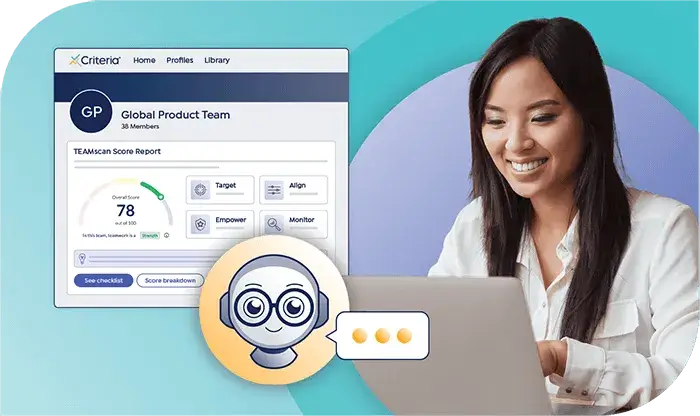
SECTION 11
Key Takeaways for How to Conduct a Job Interview
Interviewing candidates well is no small feat. It takes time, effort, and lots of planning to make sure all the pieces fall into place. We hope that this guide helps you to understand how to conduct a job interview so you can find the best person for the job.
Here are the main things we hope you take away as an interviewer:
Key steps for conducting a job interview
- Confront biases, don’t ignore them.
- Structured interviews may be more work upfront, but that work yields incredible results.
- The questions you ask should always be job-related.
- Score candidate responses in real-time and finalize your evaluations promptly after the interview.
- Clear communication with candidates is critical for building trust and providing a positive candidate experience.
A structured approach to interviewing is the secret to great hiring outcomes. It promotes objectivity and encourages you to stay focused on what matters the most: whether or not the candidate will succeed on the job. By sticking to the structure, you’ll be able to find great people to join your team.
If you’re new to interviewing, you may not get it right the first time. That’s okay! It’s a learning process, and new tools and technologies are being developed every day to help support hiring managers like you do their jobs more effectively. As you get more practice, you’ll see improvement in your interviewing skills and assurance in the interviewing process you’ve helped to create.
By following this guide, you’ll do more than just interview: you’ll interview smarter and hire with confidence.
